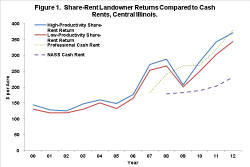 The questions before us now are: How much success comes with these
agreements? Is there a trend between the two? The questions before us now are: How much success comes with these
agreements? Is there a trend between the two?In order to find
answers, we have to start with an established definition for these
types of land agreements.
Cash rent involves property rental in which the farmer pays the
property owner a lump sum per year for use of the farmland. In
addition, the landowner may supply extra resources along with the
use of the land. Crop marketing and the timing of input purchases
fall as the responsibility of the tenant, along with the management
of tasks associated with federal aid.
Share rent, or sharecropping as it is also called, is similar to
cash rent, save that the landowner gets a share of the resulting
crop. Under this type of agreement, the farmer and landowner share
crop revenues and production costs; however, both parties also share
the financial risk.

With these definitions in mind, we turn to experts such as
economist Nick Paulson and Professor Gary Schnitkey. Paulson and
Schnitkey both provide findings on these agreements via the
University of Illinois Agricultural Extension and their farmdoc
project.

In 2011, the University of Illinois Agricultural Extension began
looking for a trend concerning these practices. According to those
findings, cash-rent levels increased by 70 percent between 1990 and
2010. Increasing cash-rent levels represented a concern for farmers
in Illinois. Between 1990 and 2010, the average cash rent in
Illinois increased from $100 per acre to $169 per acre, according to
the USDA.
In addition, the findings stated that over the past decade there
has been a shift away from share-rental agreements to cash-rent
arrangements in Illinois. The average ratio of acreage that operated
under a share-rent agreement fell from about 48 percent in 1997 to
37 percent in 2009. Acreage under cash-rent agreements, on the other
hand, increased from just over 25 percent to around 40 percent.
In essence, from those decades we can see a trend of farmers
turning away from sharecropping and moving to cash-rent agreements.

In the years that have followed this earlier study, has that
trend continued?
In August of this year, data from Illinois Farm Business Farm
Management was used to calculate returns to share-rent landowners
during the period from 2000 through 2012. Share-rent landowners'
returns increased after 2006. Returns for high-productivity farmland
averaged $343 per acre in 2011 and $371 in 2012. These returns were
above those of average cash rents.

Average cash rents were $179 per acre in 2008, $183 in 2009, $189
in 2010, $203 in 2011 and $231 in 2012. From 2008 through 2012, cash
rents averaged $197 per acre, while share-rent returns averaged $298
and $272 per acre for high- and low-productivity farmland,
respectively.
The data for share rent in 2013 is not yet available.
[to top of second column] |
 On the other hand, the data for cash rent in 2013 has been
released by the Illinois Society of Professional Farm Managers and
Rural Appraisers. In addition, the organization was able to create
some predictions for 2014.
-
For excellent-quality farmland, the 2013 cash rent
averaged $388 per acre and the 2014 cash rent is expected to
be $374 per acre, a decline of $14 per acre.
-
For good-quality farmland, the 2013 cash rent averaged
$332 and the 2014 cash rent is expected to be $318, a
decline of $14.
-
For average-quality farmland, the 2013 cash rent averaged
$278 and the 2014 cash rent is expected to be $263, a
decline of $15.
-
For fair-quality farmland, the 2013 cash rent averaged
$224 and the 2014 cash rent is expected to be $212, a
decline of $12.
Lower commodity prices have occurred in recent months, and this
has led to lower projections of 2014 agricultural returns. Lower
returns will have an effect on expectations of 2014 cash rents.
Overall, 2014 cash rents are expected to be slightly below 2013
levels.
The continuing movement away from share-rent leases to
cash-rental arrangements is likely not because of financial returns.
On the contrary, share-rent returns on average continue to remain
higher than those of cash-rent operations. Looking at the data
released by official organizations, it seems that farmers are likely
moving toward cash-rent agreements in order to retain more of the
return generated by the land they work.
In addition, it is suggested by researchers at the University of
Illinois Agricultural Department that a simpler cause may be an
aging farming population that prefers the simpler bookkeeping that
comes with cash-rent agreements.

Comparison of share-rent returns with cash rents will continue to
be of interest in the future. If the current data provides any
indication, it is likely that in an effort to find success, farmers
renting land will continue to move to cash-rent practices.
[By
DEREK HURLEY]
Articles cited:
 |